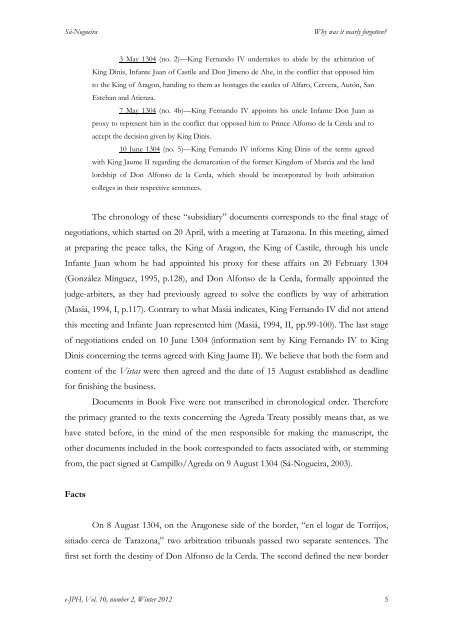Why was it nearly forgotten? The Agreda Treaty ... - Brown University
Why was it nearly forgotten? The Agreda Treaty ... - Brown University
Why was it nearly forgotten? The Agreda Treaty ... - Brown University
Create successful ePaper yourself
Turn your PDF publications into a flip-book with our unique Google optimized e-Paper software.
Sá-Nogueira<br />
<strong>Why</strong> <strong>was</strong> <strong>it</strong> <strong>nearly</strong> <strong>forgotten</strong>?<br />
3 May 1304 (no. 2)—King Fernando IV undertakes to abide by the arb<strong>it</strong>ration of<br />
King Dinis, Infante Juan of Castile and Don Jimeno de Ahe, in the conflict that opposed him<br />
to the King of Aragon, handing to them as hostages the castles of Alfaro, Cervera, Autón, San<br />
Esteban and Atienza.<br />
7 May 1304 (no. 4b)—King Fernando IV appoints his uncle Infante Don Juan as<br />
proxy to represent him in the conflict that opposed him to Prince Alfonso de la Cerda and to<br />
accept the decision given by King Dinis.<br />
10 June 1304 (no. 5)—King Fernando IV informs King Dinis of the terms agreed<br />
w<strong>it</strong>h King Jaume II regarding the demarcation of the former Kingdom of Murcia and the land<br />
lordship of Don Alfonso de la Cerda, which should be incorporated by both arb<strong>it</strong>ration<br />
colleges in their respective sentences.<br />
<strong>The</strong> chronology of these “subsidiary” documents corresponds to the final stage of<br />
negotiations, which started on 20 April, w<strong>it</strong>h a meeting at Tarazona. In this meeting, aimed<br />
at preparing the peace talks, the King of Aragon, the King of Castile, through his uncle<br />
Infante Juan whom he had appointed his proxy for these affairs on 20 February 1304<br />
(González Mínguez, 1995, p.128), and Don Alfonso de la Cerda, formally appointed the<br />
judge-arb<strong>it</strong>ers, as they had previously agreed to solve the conflicts by way of arb<strong>it</strong>ration<br />
(Masiá, 1994, I, p.117). Contrary to what Masiá indicates, King Fernando IV did not attend<br />
this meeting and Infante Juan represented him (Masiá, 1994, II, pp.99-100). <strong>The</strong> last stage<br />
of negotiations ended on 10 June 1304 (information sent by King Fernando IV to King<br />
Dinis concerning the terms agreed w<strong>it</strong>h King Jaume II). We believe that both the form and<br />
content of the Vistas were then agreed and the date of 15 August established as deadline<br />
for finishing the business.<br />
Documents in Book Five were not transcribed in chronological order. <strong>The</strong>refore<br />
the primacy granted to the texts concerning the <strong>Agreda</strong> <strong>Treaty</strong> possibly means that, as we<br />
have stated before, in the mind of the men responsible for making the manuscript, the<br />
other documents included in the book corresponded to facts associated w<strong>it</strong>h, or stemming<br />
from, the pact signed at Campillo/<strong>Agreda</strong> on 9 August 1304 (Sá-Nogueira, 2003).<br />
Facts<br />
On 8 August 1304, on the Aragonese side of the border, “en el logar de Torrijos,<br />
s<strong>it</strong>iado cerca de Tarazona,” two arb<strong>it</strong>ration tribunals passed two separate sentences. <strong>The</strong><br />
first set forth the destiny of Don Alfonso de la Cerda. <strong>The</strong> second defined the new border<br />
e-JPH, Vol. 10, number 2, Winter 2012 5
















